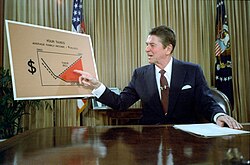User:JCO312/sandbox/reaganomics
"Reaganomics" and the economy
[edit]When Reagan entered office, the American economy's inflation rate stood at 11.83%, and unemployment at 7.1%. Reagan implemented policies based on supply-side economics, seeking to stimulate the economy with large, across-the-board tax cuts.[1][2] He aimed to reduce the growth of domestic government spending, regulation, and inflation as well.[3] In attempting to reduce or eliminate decades-long social programs and to significantly increase defense spending, while at the same time lowering taxes, Reagan's approach was a departure from his immediate predecessors.[3]
Reagan's economic policy, dubbed Reaganomics, were subject to a great deal of debate, with supporters pointing to improvements in certain key economic indicators as evidence of success, and critics pointing to large increases in federal budget deficits and the national debt.
During Reagan's tenure, income tax rates were lowered significantly, with the top personal tax bracket dropping from 70% to 28% in seven years,[4] but payroll taxes increased during Reagan's terms.[5][6] Real Gross Domestic Product (GDP) growth recovered strongly after the 1982 recession and grew during Reagan's eight years in office at an annual rate of 3.4% per year,[7] slightly lower than the post-World War II average of 3.6%.[8] Unemployment peaked at over 9.7% percent in 1982 then dropped during the rest of Reagan's terms,[2] and inflation significantly decreased.[9] A net job increase of about 16 million also occurred.

Critics of Reagan's economic polices dubbed them "Trickle-down economics,"[10] due to the large budget deficits spawned,[11] and the U.S. trade deficit expansion.[11] Reagan's policies also contributed to the Savings and Loan crisis,[12] as well as the stock market crash of 1987. In order to cover new federal budget deficits, the United States borrowed heavily both domestically and abroad, raising the national debt from $700 billion to $3 trillion.[13] Reagan described it as the "greatest disappointment" of his presidency.[13]
Reagan reappointed Paul Volcker as Chairman of the Federal Reserve, and in 1987 appointed monetarist Alan Greenspan to succeed him. While preserving the core New Deal safeguards, such as the United States Securities and Exchange Commission (SEC), Federal Deposit Insurance Corporation (FDIC), the GI Bill and Social Security, Reagan rolled back what he viewed as the excesses of 1960s and 1970s liberal policies.
Some economists, such as Nobel Prize winners Milton Friedman and Robert A. Mundell, argue that Reagan's tax policies invigorated America's economy, and contributed to the economic boom of the 1990s.[14] Other economists, such as Nobel Prize winner Robert Solow, argue that the deficits were a major reason why Reagan's successor, George H.W. Bush, reneged on a campaign promise and raised taxes.[14]
- ^ Cannon, Lou (2001) p. 99
- ^ a b Appleby, Joyce (2003), pp. 923–924
- ^ a b William A. Niskanen. "Reaganomics". The Concise Encyclopedia of Economics. Retrieved 2007-05-22.
- ^ Daniel J. Mitchell, Ph.D. (July 19, 1996). "The Historical Lessons of Lower Tax Rates". The Heritage Foundation. Retrieved 2007-05-22.
{{cite web}}: Check date values in:|date=(help) - ^ "Social Security and Medicare Tax Rates". Social Security Administration. Jul 10, 2007.
{{cite web}}: Check date values in:|date=(help) - ^ "Effective Federal Tax Rates: 1979-2001". Bureau of Economic Analysis. Jul 10, 2007.
{{cite web}}: Check date values in:|date=(help) - ^ "Gross Domestic Product". Bureau of Economic Analysis. May 31, 2007.
{{cite web}}: Check date values in:|date=(help) - ^ John Miller (July/August 2004). "Ronald Reagan's Legacy". Dollars and Sense. Retrieved 2007-06-26.
{{cite web}}: Check date values in:|date=(help) - ^ "Ronald Reagan". Microsoft Corporation. 2007. Retrieved 2007-07-27.
- ^ Danziger, S.H. (1994). "The Historical Record: Trends in Family Income, Inequality, and Poverty" in Confronting Poverty: Prescriptions for Change.
{{cite book}}: Unknown parameter|coauthors=ignored (|author=suggested) (help) - ^ a b Etebari, Mehrun (July 17 2003). "Trickle-Down Economics: Four Reasons why it Just Doesn't Work". faireconomy.org. Retrieved 2007-03-31.
{{cite web}}: Check date values in:|date=(help) - ^ "The S&L Crisis: A Chrono-Bibliography". Federal Deposit Insurance Corporation. Retrieved 2007-04-08.
- ^ a b Cannon, Lou (2001) p. 128
- ^ a b "Reagan's Economic Legacy". Business Week. Retrieved 2007-07-01.
{{cite web}}: Cite has empty unknown parameter:|1=(help)
